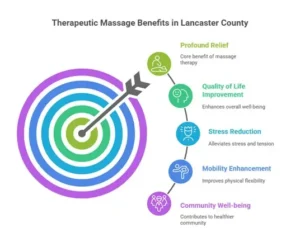For many, the word “massage” conjures images of candlelit rooms and peaceful escape. While relaxation is a wonderful benefit, it is merely the beginning. For those in Lancaster seeking real solutions to chronic pain, injury recovery, and persistent physical issues, a more targeted and therapeutic approach is needed. This is where integrative massage therapy moves beyond simple pampering to become a powerful modality for genuine, lasting healing.
The Science of Therapeutic Touch
Integrative massage therapy is grounded in physiological principles. The techniques used are specifically chosen to create positive changes in soft tissues: muscles, tendons, ligaments, and fascia.
Releasing Trigger Points & Muscle Tension
Chronic pain is often caused by hyperirritable spots within taut muscle tissue bands, known as trigger points. These knots can refer pain to other body parts, creating a web of discomfort. Through targeted techniques like trigger point therapy and deep tissue massage, a therapist can apply precise pressure to these points, releasing tension, increasing blood flow, and deactivating pain referral patterns. This process directly alleviates the source of pain, not just the sensation.
Restoring Mobility with Myofascial Release
Fascia is a thin, tough web of connective tissue that surrounds every muscle, bone, nerve, and organ in your body. When fascia becomes tight or restricted due to injury, inflammation, or poor posture, it can create pressure, causing pain and significantly limiting mobility. Myofascial release techniques involve applying gentle, sustained pressure into fascial restrictions to alleviate tension and restore sliding motion between tissue layers. This is essential for regaining full, pain-free movement.
Circulation & Inflammation Reduction
Therapeutic massage acts as a pump for your circulatory and lymphatic systems. The pressure created by hands-on work helps flush lactic acid, metabolic waste, and toxins from muscles while simultaneously delivering oxygen-rich blood and nutrients to affected areas. This process is vital for reducing inflammation, speeding recovery from injuries, and promoting cellular repair throughout the body.
The Integrative Difference: Custom Treatment Plans
What truly sets this approach apart is the absence of one-size-fits-all protocols. Your therapy session is built from the ground up based on clinical assessment.
The Assessment Process
Your session begins not on the table, but with conversation and physical assessment. Your therapist will discuss your health history and specific complaints, evaluate your posture and gait to identify imbalances, palpate muscle tissue to locate areas of tension, scar tissue, and restriction, and assess your range of motion in affected joints.
Based on the assessment, your therapist becomes a strategist, selecting the most effective tools for your specific situation. A typical therapeutic session may seamlessly integrate deep tissue work to break down severe muscle tension, PNF stretching to rapidly improve flexibility and neuromuscular function, sports massage techniques to address strain from physical activity common in Lancaster’s active community, and lymphatic drainage to reduce post-injury or post-surgical swelling.
This ability to adapt and combine techniques in real-time makes integrative massage therapy so effective for complex issues.
Who Benefits from This Therapeutic Approach
This level of targeted care is designed for a wide range of clients seeking real change.
Individuals with Chronic Pain
If you suffer from persistent back pain, neck stiffness, sciatica, or tension headaches, integrative therapy aims to identify and treat the underlying musculoskeletal causes.
Post-Injury & Surgical Rehabilitation
If you’re recovering from a car accident, sports injury, or surgery, massage therapy can significantly reduce scar tissue formation, improve flexibility, and accelerate the healing timeline as part of a coordinated rehab plan.
Lancaster’s Active Community
From runners on the Lancaster County Central Park trails to cyclists on country roads, active individuals use integrative therapy to prevent injuries, manage muscle soreness, and support athletic performance through improved muscle function.








